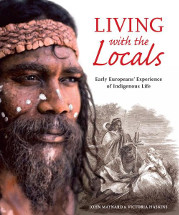Living with the locals: early Europeans' experience of Indigenous life by John Maynard and Victoria Haskins

National Library, 2016. ISBN 9780642278951
(Age: Secondary) Depicting experiences of early contact between
Europeans and Aboriginal and Torres Strait Islanders, this book
necessarily relies on primary and secondary historical sources.
Importantly however, sensible and considered anthropological
analysis is applied to better understand the records.
Nine separate experiences of colonial Europeans living with
Indigenous Australians are detailed and they all occurred on the
East coast of Australia, reaching south from the tip of Cape York
down as far as the bushland around Melbourne. Presumably Dutch and
Portuguese sailors had similar unrecorded experiences living with
Aboriginal people on the Western Australian coast, prior to British
colonisation.
British colonials found themselves living with Indigenous people for
varying lengths of time, from three months in Eliza Fraser's case to
32 years for the well-known William Buckley. This came about because
they were convicts fleeing captivity or because they found
themselves stranded as a result of shipwreck.
A common theme evident in the accounts is the incapacity for
'rescuers' and contemporary commentators to consider that living
with Aboriginal people was a valid existence which could be
considered as a permanent way of life. Some returning individuals
refused to expand on their experiences or divulge particulars
regarding social and spiritual practices, possibly to protect the
people to whom they were grateful for having saved their lives.
Others exaggerated and even fabricated aspects in order to gain
notoriety and possibly profit from journalists and speaking events.
In the case of Eliza Frazer, one can ponder whether she suffered
from a psychiatric disorder, either pre-existing or brought about by
trauma and whether this may have influenced her account. Often,
commentary which openly acknowledged kindness and the fact that
European lives were saved by people who sometimes were the victims
of terrible violence and exploitation was still patronising and
dismissive of Aboriginal society. Sadly, early colonial discussion
regarding Indigenous people on occasion tended to focus on
cannibalism when there was little evidence of it (apart from William
D'Oyley's and John Ireland's experience). Similarly, the cases of
white women living with Indigenous people were treated in a lurid
manner, implying capture and sexual abuse rather than emphasising
their salvation from certain death and generous adoption into
community.
I found it a curious experience to read this text, identifying the
ignorant and arrogant views expressed by colonial commentators and
feeling appropriately embarrassed. Any notion of being 'holier than
thou' is however dispelled by considering the accounts from the
perspective of the writers who lacked the knowledge and progressive
understanding of culture which has developed in the centuries since.
Hopefully this book will continue the process of educating
non-Indigenous people regarding the culture and society of
Australia's original inhabitants.
The text is highly relevant to the contact topic in the current
Australian history curriculum.
Rob Welsh